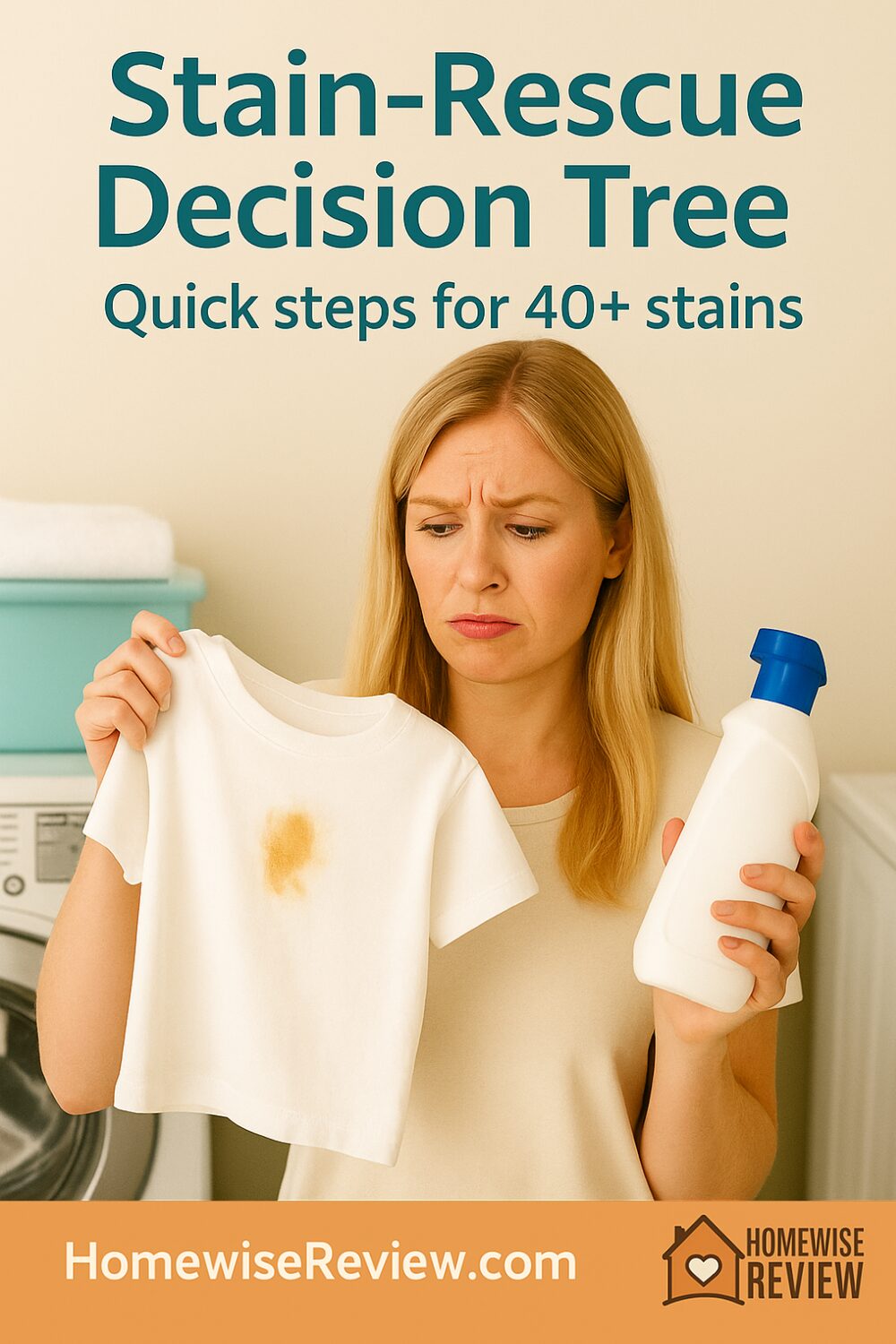
Spills happen. Coffee on a blouse, grass on school trousers, pen on the sofa. The trick is knowing what to do in the first minute so you don’t set the stain and make it worse. Our Stain-Rescue Decision Tree gives you a quick path for 40+ everyday stains with clear first steps, safe products to reach for, and the big no-nos to avoid.
- Act fast. Fresh stains are far easier to remove. Immediately blot (don’t rub) any liquid with a clean white cloth or paper towel, and gently scrape off solids once dry. Rinse spills from the back of the fabric if possible.
- Check the label. Always note the care tag. If an item is dry-clean only or made of leather/silk, send it to a pro. For washable fabrics, start with the gentlest treatment (like water or mild detergent) and test it on a hidden seam first.
- Choose water temperature wisely. Don’t use hot water on unknown or protein-based stains (blood, milk, baby formula, egg, etc.), as heat will “cook” the stain and make it permanent. Instead, start cold: soak protein stains in cold water with detergent or enzyme pre‑soak. Use warm/hot water only for colorfast tannin stains (coffee, tea, wine, fruit juice) with a detergent.
- Avoid common mistakes. Never rub with harsh soap (bar soap can set stains) or brush too aggressively (it can spread or embed the stain). Do not iron or put stained clothes in the dryer until the stain is completely gone, as heat will set it. If the first treatment doesn’t remove the stain, repeat or try a stronger (but safe) method.
Classify and Treat by Stain Type
Laundry experts group stains into categories – each has its own “first-line” treatment. Here are the most common types with examples and quick fixes:
- Protein-based stains (egg, milk, blood, baby formula, sweat, etc.) – Soak immediately in cold water or a detergent solution. For fresh blood or urine, rinse and soak in cold water; add a bit of ammonia (fresh sweat can be treated with household ammonia). Laundry enzymes (found in oxygen bleach or enzyme detergents) help break down proteins. Always wash protein stains in warm (not hot) water after pretreating.
- Tannin stains (coffee, tea, wine, juice, fruit, tomato sauce, cola, gravy, etc.) – These are water-soluble dyes. Rinse with cold water then wash in hot water with detergent (detergent, not soap!). For red wine, salt and hot water work wonders: cover the spill with table salt, then pour boiling water through the fabric over a bowl. Do not use soap, vinegar or raw baking soda as first step on tannins – plain detergent is best. If stains persist on whites, a color-safe bleach (oxygen bleach) or a little diluted chlorine bleach may help.
- Oil‑ and grease‑based stains (cooking oils, butter, makeup, lotions, salad dressing, paint, etc.) – These require a degreasing action. First spoon off excess grease (wipe off liquids), then pre-treat with a heavy-duty liquid detergent or a grease-cutting spray. Work the detergent into the stain, let it sit a few minutes, then wash in the hottest water safe for the fabric. Powdered laundry detergents can be made into a paste and rubbed in if liquid isn’t handy. (For very stubborn grease, a small amount of mineral spirits or solvent can be dabbed on first.) Always rinse well – grease can re-deposit if rinsing or wash water is too cool.
- Dye and color stains (grass, wine, berry, felt‑tip inks, markers, Kool‑Aid, mustard, etc.) – These often need two steps. First pretreat with liquid detergent, then launder. For green grass or blue berry stains, soak in an enzyme detergent or apply an oxygen bleach solution. If color remains (and the fabric is bleach-safe), follow with a dilute chlorine bleach soak on white or colorfast items. For ballpoint ink or felt‑tip (tannin ink), blot with alcohol-based solvent; RealSimple advises building a petrolelum jelly “dam” around the stain and then dabbing with rubbing alcohol. Always test a small area first.
- Combination stains (make‑up, wax, candle, BBQ sauce, cosmetics) – Tackle the oily/waxy part first, then address any colorant. For example, scrape off wax or hardened grime, then soak in warm water with detergent (add peroxide or enzyme as needed). For ketchup or BBQ sauce (oil + dye), treat the grease with dish soap or detergent first, then launder with hot water; if a stain remains, use vinegar or bleach on safe fabrics. Lipstick and lip gloss (oil + pigment) can be pretreated with a solvent or even a dab of oil, then washed normally.
Specific Stain Examples
- Grease/Oil Spills: Dot on detergent. Cover the stain with liquid detergent, add a few drops of water to make suds, and gently scrub or agitate. Rinse and repeat if needed, then wash in warm water.
- Grass/Outdoor Stains: Pretreat quickly. Apply a stain spray or detergent gel (like Shout) and scrub with a brush, then soak or wash in the warmest water safe for the fabric. For caked-on mud, let it dry and brush off, then treat as above.
- Ink (Ballpoint Pen): Contain and alcohol-clean. Surround the stain with petroleum jelly to keep it from spreading, then apply rubbing alcohol with a cotton swab or brush. Blot and repeat. If available, an ink-remover product (like Amodex) works too.
- Baby Formula or Food: Cold rinse and detergent. Blot up milk-based spills, rinse with cold water, and dab detergent (or a paste of detergent). Soak for an hour or more, then wash. (Pro tip: cold water first, since warm can set milk proteins.)
- Blood: Cold water & enzymes. Rinse under cold water immediately. For fresh blood, soak in cold water and add an enzyme laundry detergent or a bit of ammonia. Do NOT use hot water.
- Wine or Juice: Salt and hot water. Sprinkle table salt on red wine spills. Stretch the fabric over a bowl and pour boiling water through the stain. (The salt pulls out color.) Follow with a standard detergent wash.
- Sweat/Deodorant: Ammonia or vinegar. Fresh yellow underarm stains respond to a dab of ammonia, old ones to vinegar; then wash in the hottest water the fabric can take. Always launder soon after pretreating.
- Sauce (Tomato, Curry, Mustard): Dish soap & vinegar. Scrape solids, then apply a solution of dish soap and warm water. Let sit. Blot, then wash. If a trace remains, rinse with a few drops of white vinegar and launder.
- Wax/Crayon: Freeze and scrape. Rub ice on wax or crayon to harden it, then scrape away excess with a blunt knife. Place towels on both sides and iron to lift wax (the heat transfers it to the towel). Finally, treat any residue with detergent and wash.
- Odors/Mildew: Sun & vinegar. For musty clothes, sun-dry them if possible (UV light kills mold). Soak in a vinegar solution or use an oxygen bleach soak before washing.
Chemical Safety – What Not to Mix
Never mix bleach with ammonia or vinegar. These common combos produce toxic gases (chloramine or chlorine gas). For example, household bleach + vinegar emits chlorine gas, and bleach + ammonia creates chloramine fumes. If using bleach (chlorine or oxygen types), rinse well first – do not apply it right after an ammonia or acidic cleaner. Always use any stain treatment in a well-ventilated area and follow the product’s instructions.
Stain-Rescue Products & Tips
For persistent stains, specialty products can help: enzyme pre-soaks (for proteins), grease-fighting sprays, and oxygen bleach boosters.
If you have a high-efficiency (HE) washer, use only HE-rated detergent – it’s low-sudsing and made for the machine’s low-water wash cycles. (Regular detergent can oversuds and harm HE machines.)
Finally, consider a handheld garment steamer as a finishing tool. A quick steam can freshen fabric and even help lift some stains (steam relaxes fibers and loosens stains before laundering). Testers praise portable steamers like Electrolux and Pure Enrichment models for fast, safe wrinkle-and-odor removal on everything from clothing to curtains.
Key Takeaways: Blot and scrape promptly, identify the stain type, and apply the recommended treatment above. Work from mild to strong (water → detergent → solvents/bleach). And remember: never mix bleach with ammonia or vinegar. With these steps (and the right products on hand), you can rescue almost any common stain.
Sources: Expert laundry guides and cleaning science (e.g. SUNY Oneonta stains guide, RealSimple stain charts) plus health literature on cleaner safety. These sources back our quick “what-to-do-now” tips and safety warnings above. (See citation numbers for details.)




